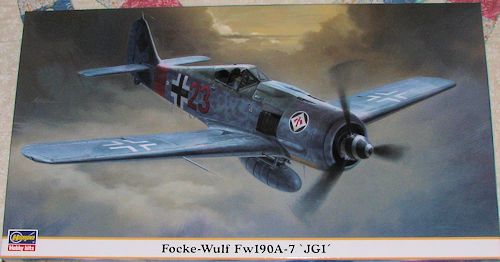
Hasegawa 1/48 FW-190A-7 'JG-1'
| KIT #: | 09902 |
| PRICE: | $24.99 on sale ($43.00 SRP) |
| DECALS: | Three options |
| REVIEWER: | Scott Van Aken |
| NOTES: | Limited Edition. 2010 boxing |

| HISTORY |
| THE KIT |
 This
is a continuation of the various FW-190A kits that have been produced by
Hasegawa. Over the years there have been dozens of limited edition boxings, some
with resin and some, like this one, with little more than a new decal sheet.
This
is a continuation of the various FW-190A kits that have been produced by
Hasegawa. Over the years there have been dozens of limited edition boxings, some
with resin and some, like this one, with little more than a new decal sheet.
There is little that is much different between all the versions aside from things like upper engine cowlings, lower wing gun shell ejector chutes, canopy and a few other bits and pieces. This one does not include the 'blown' canopy that was part of the late A-8 versions and has only the cowling for the larger 13mm guns. One thing about Hasegawa is that they rarely give you anything in the kit that is not used in making the variant that is boxed.
Some very minor surgery and hole opening will be needed on this one and in line with others in this series, the five piece cowling will need care in assembly. You'll also need to fill in some holes and panel lines as Hasegawa has chosen a near 'universal' fuselage to do the A-5 to A-9 'long fuselage' versions. I should point out that the cockpit is quite well done and while there are resin aftermarket sets for it, the 190 has a very small cockpit opening and resin is really not needed, aside from the AMS folks in the group. What is needed are some seat belts and one can either make them from tape or use one of the many etched aftermarket sets.
Instructions are the usual well done versions with
Gunze references. I also noticed several small drawings to help with alignment
and getting parts installed properly where they might be reversed. A nice touch.
Markings are for three aircraft. All of them are in RLM 74/75/76 with various
levels of side mottling. All have a broad red tail band and though there is a
decal, this would look better if painted. Two options, red 23 and red 13 are the
plane of Heinz Bar from April 1944. One has a white rudder with
 his
tally on it. The third option is for the technical officer in January 1944 and
this one has the white and black striped cowling. Decals are provided for the
black stripes, but again, I'd paint these on as getting the decal to conform
over the lumps on the side of the cowling will be problematic at best. The white
bits in this case will need to be painted on in either case. All the markings
options have yellow lower cowlings. The decals are very nicely done and include
instrument decals for those who want to use them in place of the raised panel
detail. These are the 'old school' decals with white that is actually off white.
his
tally on it. The third option is for the technical officer in January 1944 and
this one has the white and black striped cowling. Decals are provided for the
black stripes, but again, I'd paint these on as getting the decal to conform
over the lumps on the side of the cowling will be problematic at best. The white
bits in this case will need to be painted on in either case. All the markings
options have yellow lower cowlings. The decals are very nicely done and include
instrument decals for those who want to use them in place of the raised panel
detail. These are the 'old school' decals with white that is actually off white.
| CONCLUSIONS |
I'm sure many of you are wondering just how many limited edition boxings of a kit we need. Well, this is Hasegawa's way of doing business and it has worked well for them over the years. Many who buy their kits use what comes in the box in terms of markings so it provided these modelers with new subjects all the time. I have no data to back this assumption, but I'll bet that the majority of kit buyers build the kit just as it is provided with no aftermarket pieces at all. In any rate, it makes into a very nice model without any of the additional fuss and fiddly parts that are hallmarks of other companies.
| REFERENCES |
http://en.wikipedia.org/wiki/Focke-Wulf_Fw_190
2013
Thanks to me for getting this one on sale.
If you would like your product reviewed fairly and fairly quickly, please contact the editor or see other details in the Note to Contributors.